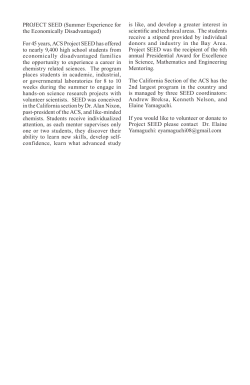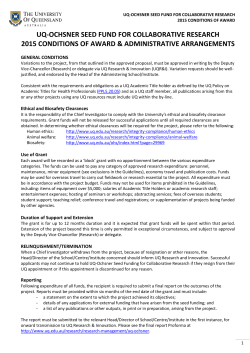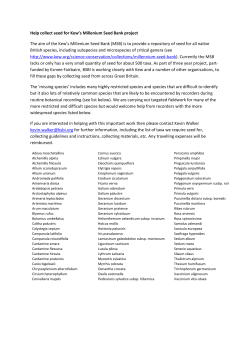
linolenic acid in seed oil of asteracantha longifolia (l
WORL PH A RMAC AND PH ARPharmaceutical MACEUTICSciences AL SCIENCES Taufeeque etD al.JOURNAL OF World Journal ofYPharmacy and SJIF Impact Factor 5.210 Volume 4, Issue 05, 1808-1814. Research Article ISSN 2278 – 4357 OCCURRENCE AND CHARACTERIZATION OF GAMMALINOLENIC ACID IN SEED OIL OF ASTERACANTHA LONGIFOLIA (L.) NEES Mohammed Taufeeque*, Abdul Malik and M.R.K. Sherwani Natural product Lab., Department of Chemistry, J.N.V. University, Jodhpur-342001, India. ABSTRACT Article Received on 15 March 2015, Revised on 06 April 2015, Accepted on 27 April 2015 The seed oil of Asteracantha longifolia (L.) Nees, family Acanthaceae has been investigated for fatty acid composition as methyl ester, using chromatographic and spectroscopic techniques. The seed oil was found to contain 3.27% of gamma-linolenic acid (GLA), an essential fatty *Correspondence for acid (EFA) and 38.52% of oleic acid as a major component of fatty Author acids. The percentage GLA of total seed was found 0.91%. Mohammed Taufeeque Natural product Lab., Department of Chemistry, KEYWORDS: Gamma-linolenic acid (GLA), Essential fatty acid (EFA), Asteracantha longifolia, Acanthaceae. J.N.V. University, Jodhpur-342001, India 1. INTRODUCTION Gamma-linolenic acid (GLA; Octadec-cis-6,9,12-trienoic acid) is an Omega-6-fatty acid, is naturally present in human milk and in wide variety of common foods, chiefly in meat.[1,2] The main sources of GLA are commercialized plant seed oils, namely evening primrose (Oenothera biennis),[3] borage (Borago officinalis)[4] and black currant (Ribes nigrum).[5] GLA is present in the seed oil of Boraginaceae species and its content to total oil has been used as taxonomical significance.[6] GLA is an essential fatty acid (EFA) and can cure the EFA deficiency symptoms.[7,8] The GLA appears in some seed oil besides very common α-linolenic acid (ALA, 18:3ω3). GLA is an important intermediate in the conversion of linoleic acid to prostaglandins, thromboxanes and other polyunsaturated fatty acids (PUFAs).[9] Prostaglandins and thromboxanes are known as hormone regulators, affect many cellular functions and also regulate some blood platelet activities.[10-14] GLA as dietary supplement show beneficial effect on various pathological and physiological conditions like inflammatory diseases, cancer, diabetes etc. and also beneficial as a cosmetic component.[4,9,15-21] www.wjpps.com Vol 4, Issue 05, 2015. 1808 Taufeeque et al. World Journal of Pharmacy and Pharmaceutical Sciences It is a desirable option to find new species, containing GLA in notable amount because of its economical value as medicinal oil and as a pure compound for research, nutritional and medicinal applications. No detailed study on fatty acid composition of the seed oil of Asteracantha longifolia (L.) Nees syn. Hygrophila auriculata has been reported so far. This paper mainly focuses on fatty acid composition of seed oil of A. longifolia containing γlinolenic acid. 2. EXPERIMENTAL SECTION 2.1 Materials Seeds were collected at maturity from arid and semi arid region of western Rajasthan (India).The whole seed was used for the analyses, they were freeze-dried and ground to powder using mortar and analyzed immediately. 2.2 Oil Extraction And Trans-Esterification Oil extraction was performed from grounded seeds of A. longifolia with light petroleum ether (40-60oC) using soxhlet extraction technique. The solvent was removed completely under vacuum using rotary evaporator. The analytical values of seed and seed oil were determined according to the standard American Oil Chemist Society (AOCS) methods.[22] Methyl esters of oil were prepared using trans-esterification technique.[23] Direct analytical TLC test[24] 2,4DNP TLC test.[25] Halphen test,[26] picric-acid TLC test[27] and alkaline picrate test[28] were also performed for indication of any unusual fatty acid. 2.3 Analyses of Fame IR spectrum of FAME was recorded by using Perkin Elmer RX-I FTIR on KBr cell. The UVVis. spectrum was performed on Perkin Elmer Lambda 15 UV/Vis spectrophotometer. Mixed fatty acid methyl esters (FAME) were analyzed in Perkin Elmer Autosystem XL gas chromatograph equipped with flame ionization detector. A capillary column of fused silica of high polarity ( SP 2330; length: 30 m; internal diameter: 0.25 mm; thickness of film: 0.2 µm ) was used. Nitrogen was the carrier gas at a flow rate of 0.75 l/min. The injector temperature and detector temperature was 260 oC. The oven starting temperature was 80 oC and increased to 200 oC at a rate of 6 oC/min, held for 5 min. then increased to 250 oC at a rate of 10 o C/min. Peaks were identified using methyl ester standards (Rapeseed oil mix and PUFAS from Sigma). www.wjpps.com Vol 4, Issue 05, 2015. 1809 Taufeeque et al. World Journal of Pharmacy and Pharmaceutical Sciences Position of double bonds was verified by a Thermo scientific TSQ 8000 Gas Chromatographmass spectrophotometer. A capillary column of polysilphenylene-siloxane ( BPX 70 TM; length: 25 m; internal diameter: 0.22 mm; thickness of film: 0.25 µm ) was used. Helium was the carrier gas at a flow rate of 1 ml/min. The injector temperature was 250 oC and detector temperature was 260 oC. The oven starting temperature was 80 oC and increased to 200 oC at rate of 8 oC/min, held for 10 min. then increased to 250 oC at rate of 10 oC/min, held for 10 min. 3. RESULT AND DISCUSSION Seed oil of A. longifolia is light yellow in colour and free from any sediments. It is liquid at room temperature (at 27±2oC). The analytical values of seed and seed oil are given in Table I. Seed of A. longifolia contain 27.97% of oil, 26.93% of protein and 3.38% of moisture content to the total seed weight. Table I: Analytical values of A. longifolia seed and seed oil Oil content 27.97% Protein content 26.93% Moisture 3.38% Unsaponifible matter 0.79% Iodine value 107.13 Saponification value 210.46 Refractive index 1.4751 Direct TLC test -ve 2,4-DNP TLC test -ve Halphen test -ve Picric acid TLC test -ve Picrate test -ve Seed oil has 0.79% of unsaponifible matter to the total oil. Iodine value and saponifible value of seed oil are 107.13 and 210.46 respectively. The seed oil and its FAME showed negative response to Direct TLC test, 2,4-DNP TLC test, Halphen Test, Picric acid TLC test and Alkaline picrate test, indicate absence of any unusual fatty acid in the seed oil. www.wjpps.com Vol 4, Issue 05, 2015. 1810 Taufeeque et al. World Journal of Pharmacy and Pharmaceutical Sciences Table II: Fatty acid composition of A. longifolia seed oil Fatty acids Percentage Myristic 3.67 Palmitic 18.76 Stearic 8.83 Oleic 38.52 Linoleic 16.31 α-linolenic 6.57 γ-linolenic 3.27 Arachidic 1.49 Behenic 0.73 Others 1.82 % GLA of total seed 0.91% Fatty acid composition of seed oil of A. longifolia is given in Table II. Oleic acid (38.52%) found to be major fatty acid. Seed oil also has sufficient amount of linoleic acid (16.31%) with 6.57% of α-linolenic acid (ALA) and 3.27% of γ-linolenic acid (GLA). GLA is found to be 0.91% of total seed. The composition of fatty acid obtained from GLC and GC-MS were in good agreement and confirm the position of double bonds. The IR spectra of FAME exhibited peak at 1738 cm-1 for carbonyl ester besides the usual peaks for hydrocarbon end, confirmed the absence of any other functional group. The IR and UV-Vis spectra of FAME exhibited no absorption band for the presence of any trans unsaturation and conjugation. Besides this, methanolic extract of A. longifolia seed show hepatoprotective activity.[29] In young and healthy individual, the Δ6- desaturase enzyme effectively catalyzes the conversion of linoleic acid to GLA.[9] It has been observed that in certain conditions like diabetes, aging, stress and alcohol consumption, the activity of Δ6- desaturase enzyme inhibit or reduce.[9,30] It has been established in medical research that GLA as dietary supplement can be effective in treatment of these conditions.[31] 4. CONCLUSION On accounting this and fair amount of oil %, protein% in seed and good amount of linoleic acid with presence of gamma linolenic acid (GLA), it could be a new source of GLA and vegetable oil. However, before considering A. longifolia as a potential source for human www.wjpps.com Vol 4, Issue 05, 2015. 1811 Taufeeque et al. World Journal of Pharmacy and Pharmaceutical Sciences consumption, the absence of toxic compounds and other parameters should be checked, this requires further investigation. ACKNOWLEDGEMENT We are indebted to Head, Department of Chemistry, J.N.V. University for providing necessary facilities and Prof. Pavan Kasera for plant identification and UGC for providing financial assistance to Abdul Malik. REFERENCES 1. Horrobin DF. Gamma linolenic acid: an intermediate in essential fatty acid metabolism with potential as an ethical pharmaceutical and as a food. Rev Contemp Pharmacother, 1990; 1: 1-41. 2. Kris-Etherton PM, Taylor DS, Yu-Poth S, Huth P, Moriarty K, Fishell V, Hargrove RL, Zhao G, Etherton TD. Polyunsaturated fatty acids in the food chain in the United States. Am J Clin Nutr, 2000; 71: 179-188. 3. Pina M, Graille J, Grignac P, Lacombe A, Quenot O, Gariner P. Research on Oenothera rich in gamma-linolenic acid. Oleagineux, 1984; 39: 593-596. 4. Gunstone FD. Gamma linolenic acid. Occurrence and physical and chemical properties. Prog Lipid Res, 1992; 31: 145-161. 5. Lercker G, Cocchi M, Turchetto E. Ribes nigrum seed oil. Riv Ital Sost Grasse, 1988; 65: 1-6. 6. Velasco L, Goffman FD. Chemotaxanomical significance of fatty acids and tocopherols in Boraginaceae. Phytochemistry, 1999; 52: 423-426. 7. Hassam AG, Rivers JP, Crawford MA. Metabolism of gamma-linolenic acid in essential fatty acid-deficient rats. J Nutr, 1977; 107(4): 519-524. 8. Hassam AG, Rivers JP, Crawford MA. Potency of gamma-linolenic acid (18:3omega6) in curing essential fatty acid deficiency in the rat. Nutr Metab, 1977; 21(1): 190-192. 9. Horrobin DF. Nutritional and medical importance of gamma-linolenic acid. Prog Lipid Res, 1992; 31(2): 163-194. 10. Anderson RJ, Berl T, McDonald KM, Schrier RW. Prostaglandins. effects on blood pressure, renal blood flow, sodium and water excretion. Kidney. Intern, 1976; 10: 205215. 11. Hedge GA. Roles for the prostaglandins in the regulation of anterior pituitary secretion. Life Sci, 1977; 20(1): 17-33. www.wjpps.com Vol 4, Issue 05, 2015. 1812 Taufeeque et al. World Journal of Pharmacy and Pharmaceutical Sciences 12. Ojeda SR, Naor Z, Negro-Vilar A. The role of prostaglandins in the control of gonadotropin and prolactin secretion. Prostaglandins Med, 1979; 2(4): 249-275. 13. Gorman RR, Fitzpatrick FA, Miller OV. Reciprocal regulation of human platelet cAMP levels by thromboxane A2 and prostacyclin. Adv cyclic Nucl Res, 1978; 9: 597-609. 14. Gryglewski RJ, Korbut R, Ocetkiewicz A. Generation of prostacyclin by lungs in vivo and its release into the arterial circulation. Nature, 1978; 273: 765-767. 15. Karlstad MD, Palombo JD, Murray MJ, DeMichele SJ. The Anti-inflammatory Role of γLinolenic and Eicosapentaenoic Acids in Acute Lung Injury, in γ-Linolenic Acid, Metabolism and Its Roles in Nutrition and Medicine. Huang YS, Mills DE. ed, AOCS Press, Champaign, 1996; 137–167. 16. Palombo JD, DeMichele SJ, Boyce PJ, Lydon EE, Liu JW, Huang YS, Forse RA, Mizgerd JP, Bistrian BR. Effect of short-term enteral feeding with eicosapentaenoic and gamma-linolenic acids on alveolar macrophage eicosanoid synthesis and bactericidal function in rats. Crit Care Med. 1999; 27: 1908–1915. 17. Poisson JP, Narce M, Huang YS, Mills D. γ-Linolenic Acid Biosynthesis and Chain Elongation in Fasting and Diabetes Mellitus, in γ-Linolenic Acid: Metabolism and Its Roles in Nutrition and Medicine, Huang YS, Mills DE, ed., AOCS Press, Champaign, 1996; 252–272. 18. Das UN. Gamma-Linolenic Acid, Arachidonic Acid, and Eicosapentaenoic Acid as Potential Anticancer Drugs. Nutrition, 1990; 6(6): 429–434. 19. Ugnarius S. Beneficial effect of GLA enriched diet theraputic properties of Oenothera biennis oil. Farmacia, 1996; 44: 11-17. 20. Das UN. γ-linolenic acid therapy of human glioma-a review of in vitro, in vivo, and clinical studies. Med Sci Monit, 2007; 13(7): RA119-131. 21. Das UN, Hypothesis: cis-unsaturated fatty acids as potential anti-peptic ulcer drugs. PLEFA, 1998; 58(5): 337-380. 22. Link WE. Official and Tentative Methods of the American Oil Chemists Society, 3 rd ed., AOCS, Champaign, IL, USA, 1973. 23. Miwa TK, Earle FR, Miwa GC, Wolff IA. Fatty acid composition of Maturing Vernonia anthelmontica (L.) willd seeds. Dihydroxyoleic acid- A possible precursor of Epoxyoleic acid. JAOCS, 1963; 40(6): 225-229. 24. Hosamani KM. Terminalia chebula seed oil: a minor source of 12-hydroxy-octadec-cis 9-enoic acid: Natural products as a source for the food and agricultural industries. J Sci Food Agric, 1994; 64: 275-277. www.wjpps.com Vol 4, Issue 05, 2015. 1813 Taufeeque et al. World Journal of Pharmacy and Pharmaceutical Sciences 25. Davis EN, Wallen LL, Goodwin JC, Rohwedder WK, Rhodes RA, Microbial hydration of cis –alkenoic acids. Lipids, 1969; 4: 356-362. 26. Halphen G. J Pharm Chim, 1897; 6: 390. 27. Fioriti JA, Sims RJ. A spray reagent for the identification of epoxides on thin layer plates. J Chromatogr, 1968; 32: 761-763. 28. Feigl F. Spot Tests,Vol. 1, 4th ed., Elsevier, New York, 1954; pp. 263 and 269. 29. Singh A, Handa SS. Hepatoprotective activity of Apium graveolens and Hygrophila auriculata against paracetamol and thioacetamide intoxication in rats. J Ethnopharmocol. 1995; 49: 119-126. 30. Phillips JC, Huang YS. Natural sources and biosynthesis of γ-linolenic acid: an overview, In: γ-Linolenic acid: metabolism and its roles in nutrition and medicine. Huang YS, Mills DE, ed., AOCS Press. Champaign, 1996; pp. 1-21. 31. Carter JP. Gamma-linolenic acid as a nutrient. Food Technol, 1988; 6: 72-82. www.wjpps.com Vol 4, Issue 05, 2015. 1814
© Copyright 2025









